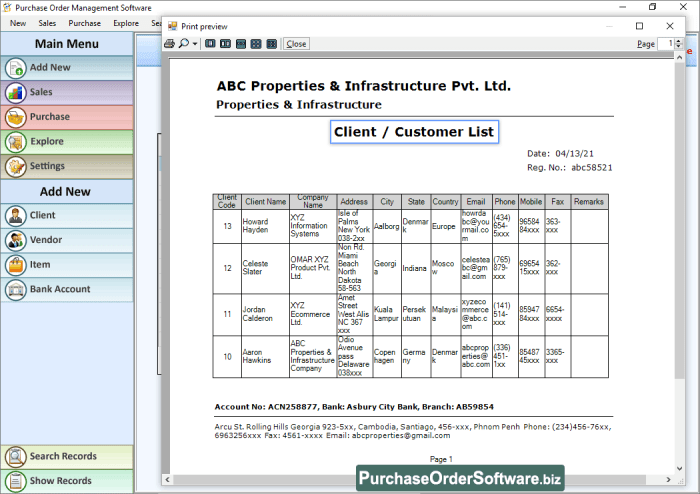Inventory and purchase order software are crucial tools for businesses of all sizes. They help manage stock levels, track orders, and automate processes, leading to increased efficiency and profitability. This comprehensive guide explores the features, benefits, and considerations of this vital technology.
Understanding the Importance of Inventory Management
Effective inventory management is key to a smooth-running business. Poor inventory control can lead to stockouts, overstocking, and ultimately, lost revenue. Inventory software helps businesses maintain optimal stock levels, ensuring they always have the right products in the right quantities, at the right time.
Key Benefits of Inventory Software, Inventory and purchase order software
- Reduced Costs: By preventing overstocking and stockouts, inventory software minimizes storage costs and reduces the risk of spoilage or obsolescence.
- Improved Accuracy: Automated tracking and real-time data updates ensure accurate inventory records, minimizing errors and discrepancies.
- Enhanced Efficiency: Streamlined order processing and automated tasks free up staff time for more strategic initiatives.
- Better Forecasting: Data-driven insights allow businesses to predict future demand and adjust stock levels accordingly.
- Improved Customer Service: Accurate inventory data enables faster order fulfillment, leading to happier customers.
Purchase Order Software: A Deeper Dive
Purchase order (PO) software is an integral part of inventory management, automating the process of ordering goods from suppliers. This includes generating purchase orders, tracking their status, and managing supplier relationships.
Key Features of Purchase Order Software
- Automated Order Generation: Software can automatically create purchase orders based on sales forecasts or inventory levels.
- Supplier Management: Centralized tracking of supplier information, contracts, and payment terms.
- Order Tracking: Real-time updates on order status, including delivery dates and potential delays.
- Automated Approvals: Streamlined approval workflows for purchase orders, reducing delays.
- Reporting and Analytics: Detailed reports on supplier performance, order fulfillment, and cost analysis.
Choosing the Right Inventory and Purchase Order Software
Selecting the right software depends on your specific business needs and budget. Consider factors like the size of your inventory, the number of suppliers, and your company’s internal processes. Look for software with scalability to accommodate future growth.
Key Considerations
- Scalability: Ensure the software can adapt to your evolving business needs.
- Integration: Check for compatibility with existing accounting and CRM systems.
- User-Friendliness: Intuitive interfaces are essential for efficient use by your team.
- Support and Training: Reliable technical support and comprehensive training materials are crucial for successful implementation.
- Cost: Evaluate the total cost of ownership, including software licensing, implementation, and maintenance.
Inventory Management Best Practices
Implementing inventory and purchase order software is only part of the equation. Robust inventory management practices are equally important. These include regular stock audits, implementing FIFO (First-In, First-Out) principles, and accurate forecasting techniques.
FAQ
- What are the different types of inventory management software? Cloud-based, on-premise, and hybrid solutions are available, each with its own set of advantages and disadvantages.
- How much does inventory management software cost? Pricing varies significantly based on features, scalability, and support packages.
- How long does it take to implement inventory software? Implementation timelines depend on the complexity of your business processes and the chosen software.
- What are the benefits of integrating inventory software with other business systems? Integration streamlines data flow, improves accuracy, and automates workflows.
Conclusion
Inventory and purchase order software are powerful tools for optimizing business operations. By implementing the right system and adhering to best practices, businesses can significantly improve efficiency, reduce costs, and ultimately, enhance profitability. Choosing the right software is a critical step towards achieving these goals. Investing in robust software solutions is an investment in your business’s future.
Further Resources: Inventory And Purchase Order Software
Call to Action
Ready to take control of your inventory and streamline your purchasing process? Contact us today for a free consultation and discover how our inventory and purchase order software can revolutionize your business.
FAQ Guide
What are the common integration challenges with existing systems?
Integrating inventory and purchase order software with existing systems can present challenges, particularly with legacy systems. Careful planning and selection of an appropriate integration solution are crucial to avoid disruptions and ensure smooth transitions.
How does this software handle different types of inventory?

Source: softwaretestinghelp.com
The software can accommodate various inventory types, from raw materials to finished goods. Customizable settings allow for the classification and tracking of specific inventory characteristics, enabling businesses to tailor their management to their unique needs.
What security measures are in place to protect sensitive data?

Source: purchaseordersoftware.biz
Robust security protocols are implemented to safeguard sensitive data. These protocols often include encryption, access controls, and regular security audits to maintain data integrity and compliance with industry regulations.